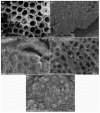A Formaldehyde Sensor Based on Molecularly-Imprinted Polymer on a TiO₂ Nanotube Array
- PMID: 28338635
- PMCID: PMC5419788
- DOI: 10.3390/s17040675
A Formaldehyde Sensor Based on Molecularly-Imprinted Polymer on a TiO₂ Nanotube Array
Abstract
Today, significant attention has been brought to the development of sensitive, specific, cheap, and reliable sensors for real-time monitoring. Molecular imprinting technology is a versatile and promising technology for practical applications in many areas, particularly chemical sensors. Here, we present a chemical sensor for detecting formaldehyde, a toxic common indoor pollutant gas. Polypyrrole-based molecularly-imprinted polymer (PPy-based MIP) is employed as the sensing recognition layer and synthesized on a titanium dioxide nanotube array (TiO₂-NTA) for increasing its surface-to-volume ratio, thereby improving the sensor performance. Our sensor selectively detects formaldehyde in the parts per million (ppm) range at room temperature. It also shows a long-term stability and small fluctuation to humidity variations. These are attributed to the thin fishnet-like structure of the PPy-based MIP on the highly-ordered and vertically-aligned TiO₂-NTA.
Keywords: formaldehyde sensor; humidity influence; molecularly-imprinted polypyrrole; titanium dioxide nanotube array.
Conflict of interest statement
The authors declare no conflict of interest. The founding sponsors had no role in the design of the study; in the collection, analyses, or interpretation of data; in the writing of the manuscript, and in the decision to publish the results.
Figures










Similar articles
-
Fabrication of a novel and simple microcystin-LR photoelectrochemical sensor with high sensitivity and selectivity.Environ Sci Technol. 2012 Nov 6;46(21):11955-61. doi: 10.1021/es302327w. Epub 2012 Oct 16. Environ Sci Technol. 2012. PMID: 23030666
-
Titanium dioxide and polypyrrole molecularly imprinted polymer nanocomposites based electrochemical sensor for highly selective detection of p-nonylphenol.Anal Chim Acta. 2019 Nov 8;1080:84-94. doi: 10.1016/j.aca.2019.06.053. Epub 2019 Jun 28. Anal Chim Acta. 2019. PMID: 31409478
-
Metal-modified and vertically aligned carbon nanotube sensors array for landfill gas monitoring applications.Nanotechnology. 2010 Mar 12;21(10):105501. doi: 10.1088/0957-4484/21/10/105501. Epub 2010 Feb 15. Nanotechnology. 2010. PMID: 20154374
-
Molecularly imprinted polymer sensor arrays.Curr Opin Chem Biol. 2010 Dec;14(6):743-50. doi: 10.1016/j.cbpa.2010.07.007. Epub 2010 Aug 3. Curr Opin Chem Biol. 2010. PMID: 20685156 Review.
-
Molecularly imprinted polymers as recognition materials for electronic tongues.Biosens Bioelectron. 2015 Dec 15;74:856-64. doi: 10.1016/j.bios.2015.07.054. Epub 2015 Jul 26. Biosens Bioelectron. 2015. PMID: 26233642 Review.
Cited by
-
Artificial Olfactory Biohybrid System: An Evolving Sense of Smell.Adv Sci (Weinh). 2023 Feb;10(5):e2204726. doi: 10.1002/advs.202204726. Epub 2022 Dec 18. Adv Sci (Weinh). 2023. PMID: 36529960 Free PMC article. Review.
-
Recent Advances in Sensing Materials Targeting Clinical Volatile Organic Compound (VOC) Biomarkers: A Review.Biosensors (Basel). 2023 Jan 9;13(1):114. doi: 10.3390/bios13010114. Biosensors (Basel). 2023. PMID: 36671949 Free PMC article. Review.
-
Gas Sensors Based on Molecular Imprinting Technology.Sensors (Basel). 2017 Jul 4;17(7):1567. doi: 10.3390/s17071567. Sensors (Basel). 2017. PMID: 28677616 Free PMC article. Review.
-
Synthesis and Applications of Molecularly Imprinted Polymers Modified TiO₂ Nanomaterials: A Review.Polymers (Basel). 2018 Nov 11;10(11):1248. doi: 10.3390/polym10111248. Polymers (Basel). 2018. PMID: 30961173 Free PMC article. Review.
-
Fluorinated TiO2 Hollow Spheres for Detecting Formaldehyde under UV Irradiation.Materials (Basel). 2024 Feb 15;17(4):904. doi: 10.3390/ma17040904. Materials (Basel). 2024. PMID: 38399155 Free PMC article.
References
-
- Lee S.-C., Guo H., Li W.-M., Chan L.-Y. Inter-comparison of air pollutant concentrations in different indoor environments in Hong Kong. Atmos. Environ. 2002;36:1929–1940. doi: 10.1016/S1352-2310(02)00176-0. - DOI
-
- Van Leeuwen F.X.R., Krzyzanowski M. Air Quality Guidelines. 2nd ed. WHO Regional Office for Europe; Copenhagen, Denmark: 2001.
-
- Occupational Safety and Health Guideline for Formaldehyde Potential Human Carcinogen. U.S. Department of Health and Human Services; Washington, DC, USA: 1988. [(accessed on 22 March 2017)]. Available online: https://www.cdc.gov/niosh/docs/81-123/pdfs/0293.pdf.
-
- Yasri N.G., Seddik H., Mosallb M.A. Spectrophotometric Determination of Formaldehyde Based on the Telomerization Reaction of Tryptamine. Arab. J. Chem. 2015;8:487–494. doi: 10.1016/j.arabjc.2011.02.005. - DOI
MeSH terms
Substances
LinkOut - more resources
Full Text Sources
Other Literature Sources

